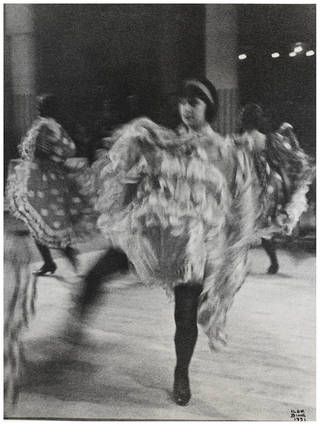Like many photographers of the 1930s, Ilse Bing was self-taught. She saw photography as providing a new visual language for the modern age, and she rapidly developed a distinctive style and a high degree of technical expertise.
Queen of the Leica
Bing used several different types of camera during her career, but was perhaps most recognised for being an early adopter of the Leica, a revolutionary small-format camera which allowed photographers to capture fast-moving events. The photographer and critic Emmanuel Sougez (who was famous for using a large-format camera) noted that Bing's use of the Leica "revived photographic dynamism". He dubbed her the "Queen of the Leica" in his review of a Paris salon exhibition in 1934.

In her later work, from about 1950 onwards, she started to work with the larger format Rolleiflex camera, and experimented with greater tonal contrast and flash – resulting in a shift away from the graininess seen in earlier work to a crisper focus in the prints. In 1957, when she was nearing the end of her photographic career, she took up colour photography.
Artistic influences
Bing's photographs from the 1930s show a range of influences and interests – from the modernist New Photography movement, to the German New Objectivity movement, Surrealism, photojournalism, the work of Alfred Stieglitz and American realist painting. She was able to sample from these different photographic styles and approaches, and yet maintain her own signature style – characterised by cropped compositions, quirky angles and aerieal views – a visual language which aligned her particularly with the New Photography movement.


Blurring and enlarging
Bing was able to capture movement with a blurred effect, as seen in her photographs of Parisian can-can dancers, which were captured on a sensitive night film using long exposures. These photographs are slightly grainy, possibly the result of having enlarged details from a small-format Leica negative. This quality was much admired by Emmanuel Sougez, who claimed that Bing was able to express the "enchantment with which reality is enveloped".

Solarisation
Light was considered the medium that permits photography. But for me it became the main subject: the protagonist of my photography.
Solarisation is said to have been invented as an artistic technique by the Surrealist artist Man Ray and photographer Lee Miller around 1930. The process happens when negatives are exposed to light in the darkroom during developing and printing, producing partly reversed images. Bing first experimented with solarisation in Paris in 1934. She claimed to have come across the technique independently, and used it to evoke what she called the 'spirit of surrealism', often in photographs of the city at night.


Printing
In the 1950s, when she was taking fewer photographs, Bing supplemented her income by teaching students the art of printing. Her photographic prints, particularly those she made in the 1940s, show that she was a very accomplished printer who managed to achieve a subtle range and depth of tone. She bequeathed a number of prints to the V&A, including vintage prints from the 1930s and 40s, as well as those she made in the 80s and 90s, in response to a revival of interest in her work. The bequest includes examples of her early work in Frankfurt as well as some of her finest photographs from the 1930s.
Find out more about Ilse Bing's life and work


